#creating drop down in google sheets
Explore tagged Tumblr posts
Text
Why Are Spreadsheets Still Used by People?

Do you Know How to creating google sheets & its use? In this Blog we provide information about How to use google sheets as a database, many user searching for a simple way to handle online Spreadsheets, and Trunao is the best solution for that, and they provide excel to web apps at an affordable price. read more hear!
#creating google sheets#simple budget template excel#google sheets as database#creating drop down in google sheets#mail merge from google sheets#google sheets for personal use
0 notes
Text
Why Are Spreadsheets Still Used by People?
Microsoft Excel spreadsheets have been around since 1985 and are the most extensively used by numerous users. Microsoft spreadsheets have been synonymous with spreadsheets which shows the market dominance of the Excel spreadsheets. Over the last few years, many competitors have come up with their spreadsheets, but they do not match the competence of Excel spreadsheets.

Only a few companies have matched Microsoft Excel's excellence, like Trunao's spreadsheet to database feature. Excel is the most commonly used tool by various users, as it is an immensely powerful and flexible tool. Everybody who works with Excel spreadsheets for their daily work knows its importance and how integral it is for the business.
However, there are a few limitations when it comes to Excel spreadsheets. You may need to edit Excel file online using third-party software so that your data is protected securely with online database conversion. Sometimes you want to share your spreadsheets with collaborators, and with the arrival of Microsoft Office 365, there is a limitation on the users. This problem is solved with Google Sheets up to some extent.
So Let's Explore Why People Still Gravitate Towards Excel Spreadsheets.
Simplicity and Familiarity
The first and foremost reason for using Excel spreadsheets is that it has been around since 1985, making it a trusted and widely used software by many small and larger companies. Irrespective of the scale of operations, various business enterprises have immensely used Excel spreadsheets. Although many Excel spreadsheets have been developed, it has not yet been incorporated into an ever-changing environment. Google Sheets have become one of the favourites among users, as it has evolved and merged the changing trends and requirements of the businesses such as mail merge Google Sheets and others
Easily Accessible
The Excel spreadsheets are cost-effective and easily available, as are the free-to-use Google sheets. The Google Sheets allow users, irrespective of their scale of operations, to use their features free of cost and organize their company data. The Google Sheets have a user-friendly user interface that can be used on any device. This can pose a problem, as sensitive and confidential data can be misused or damaged if it goes to the wrong hands. This can be solved with Trunao's Excel solutions that allow to convert Excel spreadsheet to web application free that, eliminates the risk of losing IP with no-coding builder features.
Feasibility
The simple budget template Excel and Google Sheets provide various useful tools required to collect and organize data and many more functionality features. This makes Excel spreadsheets desirable, feasible and easily available options to store and organize data. But Excel has many restrictions that make it complex. The biggest concern of using Excel spreadsheets is the security issue. Many users worry about the security of the data in the spreadsheets. Personal information, company policies, and other sensitive information are risky if improperly protected.
So What is the Solution?
If you are still using Excel spreadsheets and want to take it to the next level, Trunao is the perfect solution. Trunao allows you to edit and view files with the Excel viewer and editor software. You can easily convert Excel spreadsheets to web applications with a no-code builder feature. Users can publish spreadsheets online, collaborate with users securely and develop powerful business applications without coding. Avail Trunao's 30 days trial version and explore the advantages.
Also Visit: Which of These Five Excel Features Do You Use?
#google sheets for personal use#mail merge from google sheets#creating drop down in google sheets#creating google sheets#simple budget template excel#google sheets as database#blog#tumblog
0 notes
Text
Steps to Write 1K Words a Day (with a tight schedule)

follow for more tips 💋 || request writing tips 💌
1. Establish the Foundation
Know Your Why: Clarify your reason for writing daily by finishing a novel, building discipline, therapeutic expression, etc. Purpose keeps you going when time is tight.
Pick a Project & Stick With It: Avoid hopping between too many ideas. Commit to one main project to prevent decision fatigue.
Set a Realistic Timeframe: Determine how much daily time you actually have. Even 30 minutes can be enough with focus.
2. Shape the Writing Routine
Set a Daily Writing Slot: Choose the same 20-60-minute window each day, e.g., early morning, lunch break, and right before bed. Consistency beats chaos.
Break It into Sprints: Divide writing time into 2-3 focused sprints (10–20 minutes each) with mini-goals (e.g., 300 words per sprint).
Use Micro-Moments Wisely: Jot down scenes, lines, or dialogue in short bursts during downtime, e.g., commutes and between classes.
3. Build a Writing Habit
Create a Ritual: Start with a cue (tea, playlist, app launch), write, and end with a reward. Conditioning helps it stick.
Track Your Progress: Use a word count tracker, habit app, or physical calendar to visualize your momentum.
Aim for “Done,” Not “Perfect”: Don’t revise mid-draft. Keep the focus on finishing today’s 1,000 words, not editing yesterday’s.
4. Define Your Writing Environment
Eliminate Distractions: Silence notifications, close tabs, and let others know you’re “off the grid” during your writing window.
Use Tools That Work for You: Whether it's Google Docs, Scrivener, Word, or a distraction-free app (like FocusWriter), pick what helps you stay in flow.
Keep Materials Nearby: Outlines, scene notes, character sheets. Have them within reach to avoid losing time to memory gaps.
5. Develop Content Efficiently
Outline Briefly Before Writing: Know the scene’s goal, characters involved, and 1–2 key beats. This cuts down time spent thinking mid-writing.
Use Prompts or Templates: If stuck, use writing prompts or scene formulas (e.g., conflict ↣ tension ↣ resolution) to keep moving forward.
Lower the Stakes for First Drafts: Treat your draft as clay, not marble. Write fast, revise later.
6. Reward Yourself Consistently
Use Immediate Micro-Rewards: After each sprint, give yourself a small treat: a stretch, snack, meme scroll, or a favorite song.
Build End-of-Day Rituals: After hitting 1K, reward yourself with a guilt-free indulgence:
- A hot drink
- 30 minutes of gaming
- A mini-episode of your comfort show
- Reading time
Track for Bigger Rewards: Hit a streak (5 days? 2 weeks?) and treat yourself to something bigger: new notebook, movie night, favorite meal.
Celebrate Wins, Big or Small: Even if you only wrote 300 words, that’s progress. Celebrate effort, not just perfection.
7. Develop a Sustainable Arc
Adjust as Needed: If 1,000 words becomes overwhelming, drop to 500 and scale up again. It's better to be consistent than burned out.
Build in Break Days: Choose 1-2 buffer days per week for rest or catch-up. Remember, your brain needs recharge time.
Reflect Monthly: Look back on what worked, what didn’t, and what to change. Writing daily is a living habit, not a static rule.
Tools That Can Help
Timers: Pomodoro apps (e.g., Focus Keeper, Forest)
Trackers: Pacemaker Planner, WriteTrack
Writing Tools: 4theWords (gamified), Google Docs offline, Scrivener
Voice-to-Text Options: Google Voice Typing, Otter.ai
Examples of People with Tight Schedules Who Write Daily
Octavia Butler: Wrote early each morning before work. Do what she said, “Persist.”
Brandon Sanderson: Wrote in sprints between teaching and family time.
Toni Morrison: Wrote after her children went to sleep, hence treating every moment as sacred.
You (Eventually): With the right systems, even the busiest writer can find their rhythm.

Follow || Like || Comment || Repost || My Novel ⇚⇚⇚


thank you, i am farkle :)
#౨ৎ a.a.walker's tips ౨ৎ#writers on tumblr#writer#creative writing#booklr#artists on tumblr#aspiring author#on writing#academia#nostalgia#college#writing tips#writing tips and tricks#writing help#writing heals#writing stuff#writing resources#writing tools#writing advice#fiction writing#writblr#writer tumblr#storytelling#narrative#writers and poets#poets and writers#writers and readers#writing community#writeblr#writers and writing
89 notes
·
View notes
Text
Morro Spring Event 2025
Time for this blog's first poll ever....
Alrighty folks, pick a theme for this year's spring collab event!! (Poll closes in 1 week, so around Feb 25)
This year, we're going to aim for a more cohesive set of themed works, so the themes below reflect that.
Like last year, this event will be chill and there will be informal sign ups (a public google sheet page, will be shared later) where you can put your username down to "sign up" for a slot (or multiple slots!)
Participants will then create a work (or multiple if they wish!) that fits the specific theme item they chose. Anything goes--fics, art, gifs, cosplay, etc.
Posting time is any time from March 1 to May 31, 2025! Be sure to tag this blog or your post may be missed!
The goal is to try to have everyone do something different so we can end up with a cool set of works. The theme can be interpreted however you want, so you can take it literally or figuratively or metaphorically or whatever. (Basic example: if the theme is chess, the specific theme items would be the chess pieces--so black pawn, white pawn, black rook, white rook, etc, and everyone can sign up for different chess pieces).
Rules:
No hate (racism, transphobia, homophobia, Islamophobia, etc) will be allowed, except in the context of exploring those themes.
OCs, AUs, and other non-canon content will be allowed.
Please tag/disclose all adult content properly so we may do the same when we reblog it here (we will allow adult content but we strongly encourage you to keep it rated T as the Ninjago fandom contains a wide range of ages).
Any other questions or concerns? Feel free to drop by and ask us! This really isn't an event with a lot of strict rules as long as you have fun and respect others :)
And as always, come talk to us in the Morrotober discord server!
#i was lazy and didn't want to organize a survey this year to accept theme ideas and only did it in the discord server...#so apologies to those who had theme ideas....maybe next year!!#ninjago#ninjago morro#lego ninjago#morro ninjago#morro spring event 2025#morro spring event
64 notes
·
View notes
Text
The Great Soul Train Robbery - Spreadsheets

The Great Soul Train Robbery, by Cloven Pine Games, is a Honey Heist Hack about desperadoes robbing the Train to Hell. It's very much a pulp western meets a heist, with roll-tables for character classes and a tool for generating train cars for the desperadoes to work their way through on the way to capture whatever it is they're willing to gamble their souls for.
And I've made a Google Sheets player-kit for it!
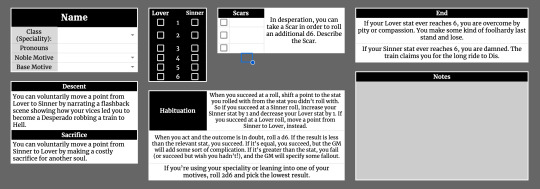
As per usual, it's got my standard Safety Tools sheet, with room for CATS, Lines & Veils, and a link to the game. It also has a character template (pictured above) that you can copy for each player, with simple drop-down menus for character options and check-boxes to help you keep track of your Lover and Sinner stats.
If you want to make a copy for your own games, you can check out the play-kit here.
If you want to see all of the play-kits I've created in Google Sheets, you can check out the folder below!
Clicky.
24 notes
·
View notes
Text
The Sims 2 JRP Spreadsheet for keeping track of your Sims!

I was editing my personal spreadsheet today when it occured to me that maybe some of you would like to use something like this too, so here it is! It started as something deeply inspired by PleasantSims spreadsheet but evolved many times over the years to what you see today. HERE'S THE LINK !!! It's based off the Pleasantview families as an empty template, but please, use it however you'd like! There are notes for things that may be a little unclear, you can delete them by clicking the RMB on a cell with the note. JUST MAKE A COPY FOR YOURSELF AND YOU'RE GOOD TO GO... BUT! If you're not very familiar with Google spreadsheets and/or not going to read the whole post, I recommend reading this: -> On your own copy you can edit anything you want, just make sure to unmerge the cells that are in your way. -> There's no zodiac sign column - I don't feel the need to keep track of it, but if you do, just follow the first point (I recommend adding it after Orientation or Vibes, less unmerging :)) -> There's some conditional formatting (pics and more details below) but feel free to change the colors or even remove it altogether. -> One column (D) has a function! More details below but if you're scared/don't want to be bothered with it you can just ignore/delete it. -> It's designed to work with other sheets (not included), that's why you can see a hidden column at the end that just adds "1" to every cell. This allows you to (for example) create charts with your hood's overall genetics if you're crazy like me

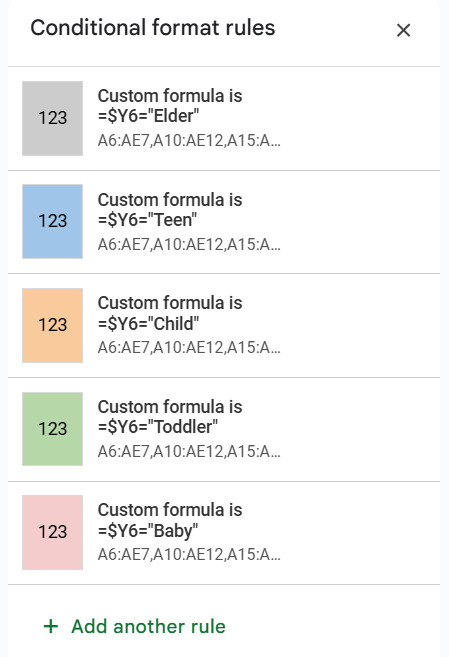
Feel free to reach out to me if something's unclear or if you need any help! Detailed description below ↓
GENERAL OVERVIEW AND HOW DOES IT WORK In the first pic you can see the whole spreadsheet with some information filled in as an example. First 3 rows are locked, meaning that you'll always see them no matter how far you may scroll! There's a lot of drop-down lists so you don't have to type in stuff like Aspirations, Turn-Ons/Offs, Hobbies, etc. You can of course edit them yourself by clicking the edit button at the end of the list! The yellow rows hold information about a whole household, below them are Sims that are currently in that household. Another yellow block means another family. You can add/drag/remove the rows with Sims to your liking (well, almost! If you want to use that function I mentioned earlier see "Second & Third Row" section"!) and if you want to add another household just copy and paste the yellow template.
FIRST ROW

Here I keep track of general informations about the whole hood: -> Day of the week -> Season -> Day - in connection to season (it used to mean an exact day of the season but I kept getting confused so now I just put there the number of days that are left of that season, a.k.a the information that the game directly gives me) -> Family tree - I know some of you (me included!) use various sites for family trees so here you can link it! -> Free space - for any notes you might have
SECOND & THIRD ROW


All the information I want to keep track of grouped into categories: Familial, Character, Romantic, Career, Hobby, Likes, Misc., Age and Genetics. I won't go over all of them, I think most of them speak for themselves. Here are some that may need additional info: -> GEN - simply generation. How you use it is entirely up to you (as this whole spreadsheet!) but if you need an inspiration see the first pic. -> Partner (F) - F means that there's a function involved! It's completely optional, you can just delete it along with the gray conditional formatting if you don't want it. How it works? If your Sim doesn't have an aspiration (so a child or below, you have to choose "N/A" in the Aspiration column) the cells in this column will automatically display "N/A". If a Sim has an aspiration, the cell will become gray to indicate that they're single and ready to mingle. If you want to input a name of a partner, I recommend clicking on the cell and putting it in the empty "" string. If you type straight into the cell you will delete the function for that cell. Similar to manually created rows - the function won't appear. No worries, you can copy it from a row above, just ensure that it has a correct row number (so a row number that you're currently on!). Is it revolutionary? No, but it was fun to learn! You can also change/delete the gray color by clicking the RMB on the column D and choosing Conditional Formating.

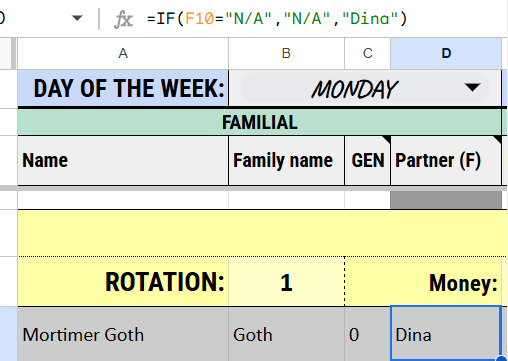
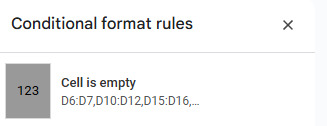
-> Personality & Vibes - the former I use to store one or more traits that the Sim has the most points in, the latter I use to additionally describe them as I see fit (examples in the first pic). If you think Vibes are unnecessary but you want to add Zodiac signs, I think this is the best place to put them as you just need to change the name of this column and you're done! -> Money & Notes - a place to keep track of your Sim's personal savings and notes -> Days until... - your Sim ages to the next age stage. Different with elders! I just input the number of days lived. -> Stage - here lies the other conditional formatting I made! Age stages are color-coded (pics are above), as with the other one, feel free to change/delete it.
HOUSEHOLD INFO - YELLOW ROWS First yellow row (merged) is the household name. In the second one you can find: -> Rotation - keep track of it however you like! I just use days played because I don't always play the same amount of days per round. -> Money - household funds -> Maid, Gardener, Nanny and Butler - do you also keep forgetting if your Sims have already hired the gardener or not? I do. I finally figured out a neat way to track it! Just tick/untick the box! -> Business - undo strike-through if the family has a business on a home/community lot -> Pets - nothing creative here, just some place to keep the information about the household's pets -> Notes - a place for your household notes! (there's never to many places for notes)
Okay, at this point you know EVERYTHING! *passes out*
6 notes
·
View notes
Text
Doctors often tell patients, often chronically ill patients to stay off the social media that talks about their illnesses and to not look stuff up, and i can understand why this may be problematic but they also aren’t taking into consideration the positives and good things that can also occur from this.
POTS and other chronic illnesses are having a higher social media presence, and because of this it’s created quite a big stigma surrounding it, and people often think that these illnesses are just becoming a trend, but they don’t understand how helpful the representation is for so many people.
I do often see people in the comment section of these videos who will have one or two traits and immediately panic thinking they have these things and i can understand how that part isn’t great, but in some cases it actually is these posts online that help people get diagnoses and learn more about themselves.
I would not have been diagnosed with POTS and getting treatment if it weren’t for social media, and my doctors don’t know much about POTS so most of the tips and advice and treatment methods that i’ve found have been from social media, and i would not be where i am without it.
I struggled with dysautonomia for my entire life, and it had been established by my one doctor who actually knew about these conditions but he retired and the new doctors i was switched too don’t know much about my health conditions, so getting diagnoses and treatment has been a very slow process.
My dysautonomia is believed to have turned into POTS in early 2021 after i got covid, and for over a year i was struggling with debilitating symptoms and had no idea why. I was just trying to survive high school, and all the sudden i was getting sicker and sicker and it was causing quite the divide socially.
I had been diagnosed with fibromyalgia, and because of it i had already been limited in my physical activity, so i was just told that my POTS symptoms were because i was out of shape.
I tried to push myself to fix this, which only ended up making me feel worse. Sometime along the road of me trying to get more active, i got a fitbit.
I started using my watch to monitor my steps and sleep, and i noticed that my heart rate would shoot up to the 150s-170s when i was simply standing still, so i sat down, and my heart rate immediately dropped to the low 100s.
I thought that this may be a glitch with my watch, but was still concerned as i was aware that my heart rate should not get that high from just standing still, so i started googling. As a result of my search, the name Postural Orthostatic Tachycardia Syndrome came up. I did some reading, and noticed that a lot of the signs were pointing to me, especially with the already established dysautonomia.
I had already dealt with a lot of doctors telling me that i was just paranoid and a hypochondriac, and i knew that watches sometimes glitched or didn’t work correctly, so i went to my pharmacy and got a pulse ox, and did the same standing test and it did the exact same thing as my watch.
I took pictures of my heart rate and started recording it on the charts that my watch had, and brought it to my next doctors appointment, explained my symptoms and then mentioned that i had heard of the condition POTS, and that it seemed pretty similar to what i was going through. My doctor had my do a short standing test in the office, and i had a 70bpm increase in my heart rate.
My doctor agreed that it definitely looked like POTS and she said that i met the criteria for a diagnosis, but she said she didn’t know very much about the condition and had only briefly heard about it, so she referred me to a cardiologist in another city as that was the closest specialist to me, but they denied the referral and said that they weren’t taking patients with POTS, and they gave her a information sheet and gave her some tests to do to rule out anything else.
The tests came back, and again it all pointed to POTS, but my doctor was scarcely familiar with the condition, and wasn’t comfortable giving me an official diagnosis, so she gave me an informal diagnosis. When it came to treatments, she also wasn’t familiar with anything besides telling me to drink more water, exercise, and increase my sodium intake, and the only medication she was familiar to treat it with was propranolol, so she prescribed that, but it unfortunately didn’t help much, so i wasn’t left with much help or advice.
The things my doctor recommended weren’t enough, and because i didn’t have an official diagnosis or really any information at all from my doctors it was hard to get accommodations with school, and i wasn’t sure what else to do, so i did what doctors recommend against and went to google and social media.
It was then where i found so many people like me who i could finally relate to, and found so much information about my condition and tips and tricks to help manage it.
Because i finally knew more about how to manage my POTS, i started trying out more things and in the last year i have learnt more than i had in years of going to doctors, and i also finally had a community where i felt less alone.
I was able to advocate for myself, and two years later, this february i finally got in to see a cardiologist and now have a proper diagnosis, and he was able to provide some more insight and treatment options for me and i’m finally starting to notice some improvement and have a hopeful plan for the future.
In cases like these, social media representation of chronic illnesses is not always bad, and can in my opinion, actually save lives. If i had not had access to these communities and help, i genuinely can say that i would not be where i am at today, and i am forever grateful for the communities that have been created.
#chronic illness#chronically ill#pots#pots syndrome#postural orthostatic tachycardia syndrome#fibromyalgia#ehlers danlos syndrome#hypermobile ehlers danlos#heds#social media#representation#rant post#awareness#chronic pain
20 notes
·
View notes
Text
Why Tableau is Essential in Data Science: Transforming Raw Data into Insights

Data science is all about turning raw data into valuable insights. But numbers and statistics alone don’t tell the full story—they need to be visualized to make sense. That’s where Tableau comes in.
Tableau is a powerful tool that helps data scientists, analysts, and businesses see and understand data better. It simplifies complex datasets, making them interactive and easy to interpret. But with so many tools available, why is Tableau a must-have for data science? Let’s explore.
1. The Importance of Data Visualization in Data Science
Imagine you’re working with millions of data points from customer purchases, social media interactions, or financial transactions. Analyzing raw numbers manually would be overwhelming.
That’s why visualization is crucial in data science:
Identifies trends and patterns – Instead of sifting through spreadsheets, you can quickly spot trends in a visual format.
Makes complex data understandable – Graphs, heatmaps, and dashboards simplify the interpretation of large datasets.
Enhances decision-making – Stakeholders can easily grasp insights and make data-driven decisions faster.
Saves time and effort – Instead of writing lengthy reports, an interactive dashboard tells the story in seconds.
Without tools like Tableau, data science would be limited to experts who can code and run statistical models. With Tableau, insights become accessible to everyone—from data scientists to business executives.
2. Why Tableau Stands Out in Data Science
A. User-Friendly and Requires No Coding
One of the biggest advantages of Tableau is its drag-and-drop interface. Unlike Python or R, which require programming skills, Tableau allows users to create visualizations without writing a single line of code.
Even if you’re a beginner, you can:
✅ Upload data from multiple sources
✅ Create interactive dashboards in minutes
✅ Share insights with teams easily
This no-code approach makes Tableau ideal for both technical and non-technical professionals in data science.
B. Handles Large Datasets Efficiently
Data scientists often work with massive datasets—whether it’s financial transactions, customer behavior, or healthcare records. Traditional tools like Excel struggle with large volumes of data.
Tableau, on the other hand:
Can process millions of rows without slowing down
Optimizes performance using advanced data engine technology
Supports real-time data streaming for up-to-date analysis
This makes it a go-to tool for businesses that need fast, data-driven insights.
C. Connects with Multiple Data Sources
A major challenge in data science is bringing together data from different platforms. Tableau seamlessly integrates with a variety of sources, including:
Databases: MySQL, PostgreSQL, Microsoft SQL Server
Cloud platforms: AWS, Google BigQuery, Snowflake
Spreadsheets and APIs: Excel, Google Sheets, web-based data sources
This flexibility allows data scientists to combine datasets from multiple sources without needing complex SQL queries or scripts.
D. Real-Time Data Analysis
Industries like finance, healthcare, and e-commerce rely on real-time data to make quick decisions. Tableau’s live data connection allows users to:
Track stock market trends as they happen
Monitor website traffic and customer interactions in real time
Detect fraudulent transactions instantly
Instead of waiting for reports to be generated manually, Tableau delivers insights as events unfold.
E. Advanced Analytics Without Complexity
While Tableau is known for its visualizations, it also supports advanced analytics. You can:
Forecast trends based on historical data
Perform clustering and segmentation to identify patterns
Integrate with Python and R for machine learning and predictive modeling
This means data scientists can combine deep analytics with intuitive visualization, making Tableau a versatile tool.
3. How Tableau Helps Data Scientists in Real Life
Tableau has been adopted by the majority of industries to make data science more impactful and accessible. This is applied in the following real-life scenarios:
A. Analytics for Health Care
Tableau is deployed by hospitals and research institutions for the following purposes:
Monitor patient recovery rates and predict outbreaks of diseases
Analyze hospital occupancy and resource allocation
Identify trends in patient demographics and treatment results
B. Finance and Banking
Banks and investment firms rely on Tableau for the following purposes:
✅ Detect fraud by analyzing transaction patterns
✅ Track stock market fluctuations and make informed investment decisions
✅ Assess credit risk and loan performance
C. Marketing and Customer Insights
Companies use Tableau to:
✅ Track customer buying behavior and personalize recommendations
✅ Analyze social media engagement and campaign effectiveness
✅ Optimize ad spend by identifying high-performing channels
D. Retail and Supply Chain Management
Retailers leverage Tableau to:
✅ Forecast product demand and adjust inventory levels
✅ Identify regional sales trends and adjust marketing strategies
✅ Optimize supply chain logistics and reduce delivery delays
These applications show why Tableau is a must-have for data-driven decision-making.
4. Tableau vs. Other Data Visualization Tools
There are many visualization tools available, but Tableau consistently ranks as one of the best. Here’s why:
Tableau vs. Excel – Excel struggles with big data and lacks interactivity; Tableau handles large datasets effortlessly.
Tableau vs. Power BI – Power BI is great for Microsoft users, but Tableau offers more flexibility across different data sources.
Tableau vs. Python (Matplotlib, Seaborn) – Python libraries require coding skills, while Tableau simplifies visualization for all users.
This makes Tableau the go-to tool for both beginners and experienced professionals in data science.
5. Conclusion
Tableau has become an essential tool in data science because it simplifies data visualization, handles large datasets, and integrates seamlessly with various data sources. It enables professionals to analyze, interpret, and present data interactively, making insights accessible to everyone—from data scientists to business leaders.
If you’re looking to build a strong foundation in data science, learning Tableau is a smart career move. Many data science courses now include Tableau as a key skill, as companies increasingly demand professionals who can transform raw data into meaningful insights.
In a world where data is the driving force behind decision-making, Tableau ensures that the insights you uncover are not just accurate��but also clear, impactful, and easy to act upon.
#data science course#top data science course online#top data science institute online#artificial intelligence course#deepseek#tableau
3 notes
·
View notes
Note
hi!! thought i'd direct my ask here since it's writing related -> how did you set up the google sheets to set and track word goals?? i opened up a sheets but it's a bit intimidating ;;
i'm guessing you do Insert>function>??? one of those? but idk which
there are a lot of different ways!! some basics to know:
the main functions i may use here are =SUM, =AVERAGE, =COUNTIF then follow the formula outline
more frequently i stick = in the formula box then select cells (or tab you want then its cells) with my mouse (a quicker way than typing cell or tab names)
but you can also limit cells usage by editing formulas directly in the cell you want to see the = in (like, you can have a cell with "=2+2" or a cell with "=A1+A2" with the numbers in them. both cells will have the same total calculated by the = but the formula bar will look different). Data Managers™️ recommend keep everything visible in cells, but we aint publishing this so do what you want
i also use cell formatting as % or date or whatever for less formula writing (% for example, i otherwise gotta do whatever math is needed for calculating that when i can just do the basics then ask it to do the rest AND it adds a % sign for me)
now let me go from least to most complicated set-up at start:
1. Total at Bottom
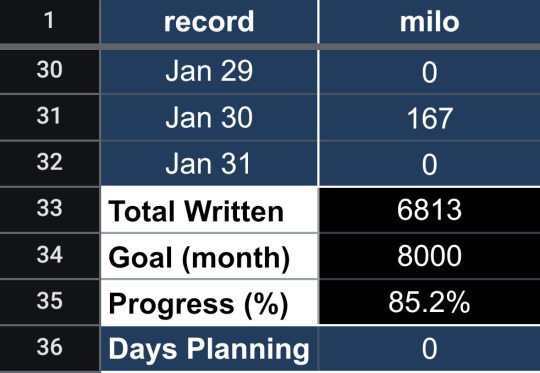
i got this settup to track multiple people at once, but you can keep the record column as Day 1, Day 2, etc and change the name columns to be months. Formulas:
row 33 Total Written =SUM(B2:B32) (alter the letter and number depending on column and days in month)
row 34 Goal (month) [free write #]
row 35 Progress (%) =B33/B34 , aka =[Total Written cell/Goal (month cell] format as %
row 36 Days Planning =COUNTIF(B2:B32, "planning") (or whatever specific word you want)
you can also have a year total somewhere, which you can see examples of how to in the last method
2. Weekly Goal
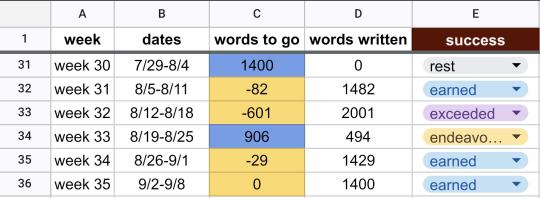
there's more manual in this so far which makes it easier to setup, harder to keep up on. columns week, dates, and words written are write-in (the last which i may =#+#+# throughout), but formulas:
column c words to go =1400-D31, aka =[word count goal]-[relevant "words written" cell]. conditional formatting (which i may swap the colors):
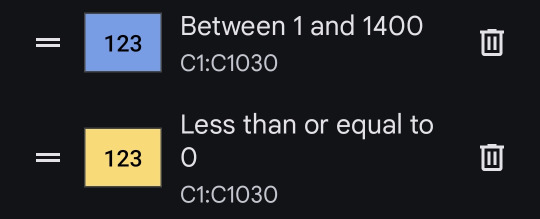
column e success is a drop-down menu which i forget how to create every time... look up "how to create drop-down menu in [spreadsheet program of choice]". i manually select the success based on vibes: earned, endeavored, exceeded, and resting
3. Detailed Year
there are two tabs here with more initial setup but less to manage later. they read from each other (what the ! does in a formula). starting with the daily data tab:
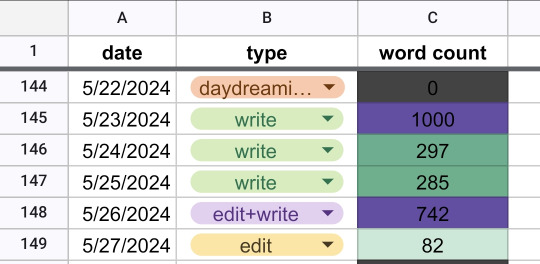
column date is formatted for calendar
column type is formatted with a drop-down menu, which the thought is to later make a pivot table counting the frequency of write, edit, edit+write, and daydreaming.
column word count is a manual input with conditional formatting
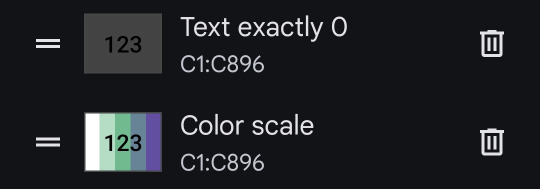
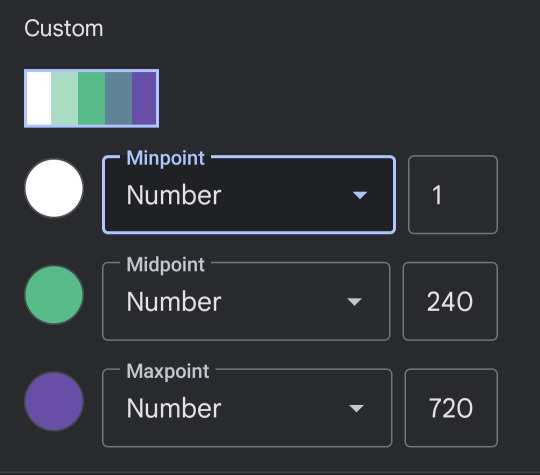
then the year tracking tab:
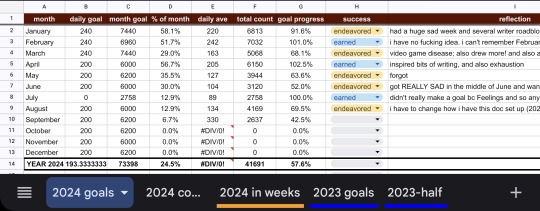
the free write-in columns are month, daily goal, and reflection. the column success is a drop-down i manually select at end. everything else has formulas:
column c month goal =[daily goal cell]*[# days of that month]
column d % of month will look like =(COUNTIF('2024 count'!C246:C275, ">0"))/30 , aka (COUNTIF('[name of daily data tab]'![relevant cell range from tab],">0"))/[days of month] formatted as %
column e daily ave is =AVERAGE(('[name of daily data tab]'![relevant cell range])
column f total count is =SUM('[name of daily data tab]'![relevant cell range]
column g goal progress is =[total count cell]/[month goal cell] formatted as %
the total row at the bottom goes like
daily goal =AVERAGE([above cells])
month goal =SUM([above cells])
% of month =AVERAGE([above cells])
daily ave =AVERAGE([above cells])
total count =SUM([above cells])
goal progress =AVERAGE([above cells])
yea that's about it
#i struggle with math so much that i took what i learned in my college classes on spreadsheets and sprinted alxlshckx#an organized calculator just for me that i can have it automatically color code?? Yes Pls#word count progress#asks#the weekly goal one is still a wip. hence why it's clunkier
6 notes
·
View notes
Note
fuck me please, dominate me, top me, make me your good boy, call me a fag, slap me, no lube, no protection, all night, all day, from the kitchen floor to the toilet seat, from the dining table to the bedroom, from the bathroom sink to the shower, from the front porch to the balcony, vertically, horizontally, quadratic, exponential, logarithmic, while I gasp for air, scream and see the light, missionary, cowgirl, reverse cowgirl, doggy, backwards, sideways, upside down, on the floor, in the bed, on the couch, on a chair, being carried against the wall, outside, in a train, on a plane, in the car, on a motorcycle, the the bed of a truck, on a trampoline, in a bounce house, in the pool, bent over, in the basement, against the window, have the most toe curling, back arching, leg shaking, dick throbbing, fist clenching, ear ringing, mouth drooling, ass clenching, nose sniffling, eye watering, eye rolling, hip thrusting, earthquaking, sheet gripping, knuckles cracking, jaw dropping, hair pulling, teeth jitterbug, mind blogging, soul snatching, overstimulating, vile, sloppy,moan inducing, heart wrenching, spine tingling, back breaking, atrocious,gushy, creamy, beastly, lip biting, gravity defying, nail biting, sweaty, feet kicking, mind blowing, body shivering, orgasmic, bone breaking, world ending, black hole creating, universe destroying, devious, scrumptious, amazing, delightful, delectable, unbelievable, body numbing, bark worthy, can't walk, head nodding, soul evaporating, volcano erupting, sweat rolling, voice cracking, trembling, sheets soaked, hair drenched, flabbergasting, lip locking, skin peeling, eyelash removing, eye widening, pussy popping, nail scratching, back cuts, spectacular, brain cell desolving, hair ripping, show stopping, magnificent, unique, extraordinary, slendid, phenomenal, mouth foaming, heavenly, awakening, devils tango ever bro could cause a nuclear bomb inside me and I'd still ride.
is this from google
2 notes
·
View notes
Text
Want to Make Art Without AI? Try These 12 Free Ideas Instead.
Let’s be honest.
Right now, it feels like AI is making everything—art, music, stories, even your friend's new profile pic. And yeah, it’s cool… but also a little exhausting.
What happened to just making stuff with your own two hands? No algorithms. No prompts. No “please wait while we generate your masterpiece.”

Just you, your brain, your mess, and that spark inside you that wants to create something real.
If that sounds like your vibe—this list is for you. Here are 12 creative ideas you can try TODAY, completely AI-free, totally human, and best of all… free.
✍️ Keep a “No Rules” Sketchbook No judgment. No skill level required. Just draw anything—a coffee mug, your hand, weird spirals, or your cat looking personally offended by your presence. It’s your space.
Use receipts, junk mail, whatever. Art doesn’t need a canvas.
🎨 Paint With Whatever You’ve Got No fancy paint set? Try this:
Brewed coffee (warm, earthy tones)
Beet juice (hello, moody red)
Makeup you never wear
DIY brushes (old toothbrushes, sticks, kitchen sponges)
It’s messy. It’s weird. It’s magic.
✂️ Make a Trash Collage Grab old magazines, junk mail, or cereal boxes. Cut, glue, rip, remix.
You don’t need to draw a thing—just layer colors, textures, or random words and watch it turn into something so cool.
🛠 Build a Mini Sculpture From “Useless” Stuff Cardboard. Broken pens. Bottle caps. Wire. Bubble wrap.
If you’ve got tape or glue, you’ve got a sculpture. Make a weird little creature. A spaceship. A desk buddy. Something glorious and useless.
📓 Fold a Zine & Tell Your Truth Zines = tiny DIY books filled with your thoughts, doodles, poems, or random rants. No filter. No likes. Just honesty.
You can make one with a single sheet of paper. Google “8-page zine fold” and go.
👁 Draw Something Without Looking at the Page It’s called blind contour drawing. Pick an object. Don’t look at your sketchbook. Keep your pen on the paper and draw in one line.
The result? Hilarious, haunting, raw—and somehow deeply you.
🌿 Make Art With Nature Step outside. Pick up some leaves, sticks, rocks. Arrange them in a circle. Press them into paper. Stamp them in paint. Or just take a photo and let the wind scatter it.
Art that disappears is still art.
🖐 Finger Paint Like You’re 5 Again Scoop some color. Smear it. Swipe it. No brushes. No technique. Just you and color and movement.
This isn’t “childish”—it’s therapeutic as hell.
🧵 Stitch Something By Hand Grab a needle and thread. Find an old shirt or sock. Start stitching patterns, patches, or random shapes.
Embroidery = drawing with thread. And it’s calming AF.
📸 Take a “No-Edit” Photo Walk Take your phone. Go outside. Look for something beautiful, weird, or overlooked. A shadow. A rusty pipe. A cloud shaped like a goose.
Don’t filter it. Don’t fix it. Just notice it.
✒️ Let Your Pen Draw Without Thinking Put your pen down. Close your eyes. Move your hand.
It’s called automatic drawing—like freewriting, but visual. Let your hand wander. It’s weirdly freeing.
✉️ Make Mail Art and Send It to a Friend Cut a cereal box into a postcard. Paint it. Doodle. Add stickers. Write a note. Drop it in the mail.
Art doesn’t need a gallery. Sometimes it just needs a mailbox.
🧠 Reminder: You Don’t Need AI to Be Creative You don’t need perfect tools. You don’t need fancy skills. You don’t need to “keep up” with anything.
You just need a moment to try.
Because honestly? The world doesn’t need more AI-generated perfection. It needs your messy, weird, glorious, one-of-a-kind humanness.
So go make something. And don’t wait for permission.
💬 Share This With Someone Who Needs a Creative Reboot If this gave you a spark, pass it on. Tag your favorite analog artist. Try one idea this week. Share your messy results. Let’s take back the joy of making—for no reason but the love of it.
0 notes
Text
6/14 - FIST PUMP
IM WRITING IM WRITING AAAA
Hi journal,
Ok, so I did write out a list of shit on google docs but I really want to get this journaling habit down. So start writing you goon.
Ok so stream of concious: I want to go on my soft masc journey. Really want to flag better. Alexa, how do I find girl friend (づ_ど)
Still overwhelmed, whats new. Lots of shit I got to deal with and unfortunatly streaming is taking a back seat because of it. I get so fucking anxious its awful. I can only get on stream rn whn Im high or drunk. Thats fucking awful.
I got to move. Its taken forvever for this moment to come (I expected house construction to be finished last year woops) but now that its here I don't feel ready. I should sit down and plan out my room because I need to pick a paint color tommorw. I'm debateing between dark green or charcoal. They both feel safe in their own way: Charcoal would be too dark for people but is a safe color for me because black goes with everything but green is a risk for me, I dont have green-matching rugs or anything and Its really millenial core imo but who the fuck cares when you are the millenial. I have to have satin sheets and pillowcases for my skin and curly hair and they are in some nice pinks that would go with the green but TBH kinda want to replace them cause they are pilling bad. It would be wasteful tho rn so its the last thing to replace.
Man Im tired of living in unprecedented times.
I really want to get into fanfic writing and fan art creating, fandom spaces kind of scare me but I just want to indulge. I need a space that doesn't feel like im masking in it. I never really got really super into fandom spaces. I enjoyed the content from afar but i feel like I have never connected with anyone of the hyperfxation level I get which is something that saddens me. I want to be able to have someone to talk to in these euphoric moments of engageing in fan works and enjoying them so much I NEED to share.
drinking a beeeeeer I have been kinda a recluse(to a degree) for months now. I only talk to family and thats it. I want to get out. I find myself making quips and being a little bit more chatty with strangers recently, no mater how awkward I feel, just to have someone to talk to. I do talk to people in stream and discord and I consider many very close friends but I desire community and closeness so much. I need queer friends in person. Why did I have to move to a fucking nasty southern state.
I don't know how to describe this feeling but its like Ive been floppy recently. Like its kind of painful to do anything. I want to just lay in bed. Reading older entries in the journal I noticed saying this previously but it feels like so much. I feel heavy. I feel a headache coming on. I feel like i have to have music in the background. I feel like I'm wasting time. I feel like I can't manage anything. I feel like I'm just a huge whiney babey for struggling so much. I wish I could get a therapist. I have a doc appointment next week which I will bring up. I think I need serious mental help. Like not sewer slideing levels but just. I want to give up. I want to rot. I want everything to stop feeling like too much. I want want want want want. I want to stop being a perfectionist and looking for the tiniest details to get upset over. i want to stop just only being able to space out and dwell on my misfortunes and my to do list. I have catered my life to be so fucking minimal and I still stuggle. I push an obstacle out of my way and new ones get dropped in my life. And because I'm so sensitive and prickley right now even the tiniest pebbles feel like an avalanche. I think I need to start time blocking. Again... I used to. I think my habits are just so bad rn.
I have some ideas for writing prompts I want to put out related to Jayvik and wondering if I should make a seperate blog account for fandom engagement since this one is a thought dump. I don't want to really manage another blog tho. Alright, time to work on some other stuff. music: Deftones - Beware / cloudyfield -in your head / Post Sulphur Band - Devil In The Churchyard
0 notes
Text
Automate Anything with Ease: A Beginner’s Guide to n8n Workflows

Imagine sipping your coffee while tasks run themselves—emails get sorted, data gets transferred between apps, and reminders are sent out—all without lifting a finger. Sounds dreamy, right? That’s exactly what automation tools like n8n can help you achieve. Whether you're a solo entrepreneur, freelancer, content creator, or just someone who wants to do more with less effort, learning n8n for Beginners: Build Automations from Scratch!! is your ticket to unlocking that superpower.
But what is n8n? Why should you even care about it? And most importantly—how can you use it without needing to be a coding wizard?
Let’s break it down, the simple way.
What is n8n?
n8n (pronounced “n-eight-n”) stands for “nodemation”—basically, node-based automation. It’s a free, open-source workflow automation tool that helps you connect different apps and services together. It’s kind of like Zapier or Integromat, but with more control and flexibility.
Here’s what makes n8n stand out:
✅ Open-source (so it’s customizable and free)
✅ Self-hosted or cloud (your choice)
✅ Powerful workflow builder
✅ Connects to 200+ apps (and growing)
✅ No-code/low-code platform
In other words, it gives you a visual playground where you can build automations—without needing to be a tech genius.
Why Automations Matter (Especially in 2025)
Time is your most valuable currency. In 2025, with the explosion of digital tools and platforms, we’re constantly switching between emails, CRMs, spreadsheets, Slack, Discord, social media—and the list goes on.
Manual work slows you down.
Automation helps you:
✅ Eliminate repetitive tasks
✅ Boost productivity
✅ Reduce human error
✅ Scale your business or operations faster
Now imagine setting up workflows in minutes that save you hours every week. That’s what n8n delivers.
Getting Started: Is n8n Really for Beginners?
Short answer? Absolutely.
Even if you're new to the world of automation, the n8n for Beginners: Build Automations from Scratch!! course guides you step-by-step in a super friendly, visual way.
You’ll learn:
✔️ How to install and access n8n
✔️ How to design your first workflow
✔️ Real-world automation examples (not boring theory)
✔️ How to connect tools like Gmail, Notion, Slack, Trello, etc.
✔️ How to automate your business processes like a pro
No need to be a developer. Just follow along, and you’ll be creating time-saving automations in no time.
Real-Life Examples: Where n8n Shines
Still wondering what kind of things you can automate? Let’s look at some real-life use cases:
📧 1. Automate Emails Based on Triggers
For example:
When someone fills out your contact form, send them a personalized email.
Notify your team on Slack or WhatsApp.
📋 2. Sync Your Spreadsheets
Say you update a Google Sheet with new leads—n8n can automatically add those leads to your CRM or Mailchimp list.
🔁 3. Social Media & Content Scheduling
Automate content posting across platforms like Twitter, Instagram, or LinkedIn. Trigger a post every time a blog goes live.
🔔 4. Reminders & Notifications
Create workflows to remind you about pending tasks, renewals, or client meetings.
📊 5. Reporting & Dashboards
Pull data from multiple platforms and generate auto-reports at the end of every week or month.
And that’s just the beginning.
How Does n8n Work?
Picture a flowchart. You start with a trigger (e.g., new email received), then add a node (e.g., filter emails with a certain subject), then another node (e.g., send a message to Slack), and so on.
Each step is a node in your workflow, and you can drag, drop, and configure them with a few clicks.
Here’s the typical workflow logic:
Trigger (an event like form submission)
Actions (do something based on the trigger)
Conditions (set filters or logic)
End Result (email, message, file, update, etc.)
And voilà—your automation is ready!
Why Choose n8n Over Other Tools?
There are many automation tools out there. But here’s why n8n is increasingly becoming the go-to platform: Featuren8nZapierMake (Integromat)Open Source✅ Yes❌ No❌ NoFree Tier LimitVery GenerousLimitedLimitedSelf-Hosting Option✅ Yes❌ No❌ NoCustom LogicHighly FlexibleLimitedModerateVisual Editor✅ Yes✅ Yes✅ Yes
n8n gives you the best of both worlds—no-code friendliness with advanced customization if you ever need it.
The Power of Self-Hosting (Optional but Awesome)
Want total control over your data and infrastructure? Self-hosting n8n is a game-changer. You can deploy it on your own server (VPS, Raspberry Pi, etc.) and have:
🔒 Full privacy
🔄 Infinite workflows
💰 Zero subscription costs
Don’t want to deal with servers? No worries. You can also use n8n.cloud, the official hosted version.
Top Benefits You’ll Gain from Learning n8n
Still on the fence? Here’s why learning n8n is 100% worth it:
🚀 Save time and money by replacing expensive tools
🎯 Sharpen your productivity skills
🧠 Become automation-savvy—a must-have skill in 2025
💼 Boost your resume if you’re in tech, marketing, or operations
🧰 Use it across any industry (marketing, SaaS, eCommerce, HR, etc.)
💡 Unlock ideas for your own projects or side hustles
Who Should Take This Course?
If you’re asking yourself, “Is this course for me?”—here’s who it’s perfect for:
Entrepreneurs looking to automate and scale
Freelancers and solopreneurs
Digital marketers
Virtual assistants
Developers who want low-code tools
Students or beginners in tech
Anyone tired of manual tasks!
If that sounds like you, then n8n for Beginners: Build Automations from Scratch!! is your perfect match.
Learn by Doing (Not Just Watching)
This course isn't just about watching tutorials—it’s hands-on. You’ll build real workflows step-by-step and walk away with automation superpowers you can use immediately.
And it’s beginner-friendly, so no prior experience is required.
Future-Proof Your Skills
Automation is not just a buzzword. It’s a business essential.
Companies are actively seeking people who can automate tasks, optimize processes, and manage workflows. Knowing how to use n8n gives you:
💼 A competitive edge in the job market
🔧 Practical skills to improve operations
💰 Opportunities to offer automation as a freelance service
You’re not just learning a tool—you’re future-proofing your career.
Final Thoughts: Start Automating Today
You don’t need to be a developer. You don’t need fancy software. All you need is the right guidance.
n8n is powerful, flexible, and accessible. With the right training, you’ll go from beginner to automation master in no time.
So why wait? Start building your first automation today with n8n for Beginners: Build Automations from Scratch!! and unlock a whole new level of productivity.
Let your workflows do the work—while you focus on what truly matters.
0 notes
Text
How to Use the 2–7–30 Trick to Lock in 90 Percent of Everything You Learn
Ever finish a book or binge a webinar and feel on top of the world—only to forget most of it days later? You’re not alone. Most of us struggle to retain new information. But what if you could remember 90% of what you learn, using just a simple schedule?
Enter the 2–7–30 trick. It’s a brain-friendly memory hack based on science and psychology—and once you try it, you’ll wonder how you ever studied without it.

What Is the 2–7–30 Trick?
The 2–7–30 method is a spaced repetition strategy designed to help you retain new information long-term. You revisit what you’ve learned at three key times:
Day 2
Day 7
Day 30
These three checkpoints align with the brain’s natural forgetting cycle. Every time you review, you're refreshing the neural pathways tied to that information, making it easier to recall in the future.
Think of it like applying a coat of memory paint—each layer seals the knowledge deeper.
The Science Behind Why It Works
This trick isn’t just trendy—it’s backed by over a century of research.
In the late 1800s, psychologist Hermann Ebbinghaus discovered the Forgetting Curve, which shows how fast our brains drop newly learned information. According to Ebbinghaus:
You forget nearly 50% of what you learn within 24 hours
You forget around 80% by the end of the week
Unless you actively review it, your brain simply decides it’s not important enough to keep.
The 2–7–30 method flips that script. By spacing out reviews before the brain “lets go,” you’re teaching it: Hey, this matters—keep it!
How to Actually Use It (With Real-Life Examples)
Let’s break this down with a simple scenario.
Say you start a course on graphic design on Monday:
Day 2 (Wednesday): Spend 10 minutes reviewing key concepts. Maybe rewatch a quick clip, skim your notes, or quiz yourself on 3 main ideas.
Day 7 (Next Monday): Take 15-20 minutes to go deeper. Try explaining concepts aloud, teaching someone else, or applying what you learned in a small project.
Day 30 (Next Month's Wednesday): Time for a recap! Revisit your notes or try something hands-on like recreating a design using the same techniques.
Each review session doesn’t have to be long. The magic is in timing and engagement, not duration.
Why Those Specific Days?
The 2–7–30 timeline isn’t random. It’s perfectly timed to hit just before your brain lets information go:
Day 2: You’re already forgetting fast—this first review stops the slide.
Day 7: You’ve lost even more—this review locks it in deeper.
Day 30: Your brain is either going to toss it or save it forever. This review makes the decision easy.
These spaced intervals mimic how memory naturally consolidates. You’re not fighting your brain—you’re working with it.
Make It Stick: Tips for Each Review
Here’s how to maximize each review day:
Day 2 — Quick & Light
Skim your notes or summary
Quiz yourself briefly
Write a 1-minute “explain it like I’m five” summary
Talk it out aloud (seriously—even to your pet!)
Day 7 — Go Deeper
Make a mind map
Apply what you learned to a small project
Connect it to real-life examples
Teach it to someone else
Day 30 — Cement It
Reflect on how you’ve used this info
Create a recap from memory, then check your gaps
Add extra context or layers (ex: “What’s changed since I learned this?”)
Bonus Tools to Automate the Process
Don’t want to remember when to review? Let tech help:
Anki: A spaced repetition flashcard app that follows science-backed intervals.
Quizlet: Easy flashcard creation and shared decks.
Google Calendar: Set recurring reminders at Day 2, 7, and 30.
Notion/Obsidian: Build your own knowledge base with review dates built in.
You can even print a cheat sheet or use a paper planner to manually track your 2–7–30 reviews if you’re more of an analog learner.
Want to Supercharge It? Use Active Recall
Spaced repetition is powerful. But pair it with active recall, and you’ve got a learning superpower.
Here’s what active recall looks like:
Write down everything you remember before checking notes
Use flashcards with open-ended questions
Practice the Feynman Technique: explain concepts in plain English, spot where you struggle, and refine
This pushes your brain to retrieve, not just recognize—which builds stronger memory pathways.
Customize Based on What You’re Learning
The 2–7–30 rule is flexible.
If you’re learning:
Simple facts: The 3-point review is plenty.
Complex skills: Add an extra review on Day 14 or Day 21.
Fast-paced content: Like daily lectures or high-volume reading? Stack multiple 2–7–30 sequences across topics.
Learning isn’t one-size-fits-all. Use this as a framework, then adapt as needed.
Combine with Interleaving for Even More Power
If you really want to level up, mix in interleaving—the practice of switching between related topics instead of studying one thing straight through.
Example: Studying finance? Instead of doing one day of stocks, one day of budgeting, one day of crypto—mix all three in one session.
Why? Your brain gets better at distinguishing concepts, and it trains you to apply knowledge in flexible, real-world ways.
Track Your Progress (So You Know It’s Working)
Here’s a simple way to track:
What you learned
Review date
Self-rating: 1 to 5 stars on how well you recalled it
Over time, you’ll see patterns. You’ll know which subjects stick fast—and which need extra love.
The Results? More Retention, Less Relearning
Stick with the 2–7–30 method, and you’ll:
Retain more knowledge with less effort
Learn faster because you’re not relearning the same things
Feel more confident applying what you know—in meetings, on tests, or in projects
The best part? It doesn’t take hours. Just a few focused minutes, a few days after learning, and boom—you’ve locked it in.
Final Thoughts: Make Forgetting a Thing of the Past
Let’s be real: life is busy. You don’t always have time to re-read whole books or re-watch hours of content.
That’s why the 2–7–30 trick is so powerful. It’s simple. It’s doable. And it fits into real life.
So next time you learn something new—whether it's from a podcast, a course, or a random deep dive into AI or finance—schedule your 2–7–30 reviews. Set a reminder. Build the habit.
Because the smartest people aren’t the ones who know the most. They’re the ones who remember what matters—and use it when it counts.
Ready to try it out? Start small. Pick one thing you learned today and map out your 2–7–30. You’ve got nothing to lose… and nearly 90% more knowledge to gain.
0 notes
Text

Semester is closing in...
End of Semester 5.21.25
Closing out your courses
Export your Canvas Course into a Development Shell (DS). How to get a Development Shell and keep a backup offline.
Download Gradebook & Quizzes Text Tutorial & Cara’s Video
How to create back-ups of files of your grades and courses (4:52)
Submitting Grades: Use drop-down on the grade sheet to “Approved” & click on that teeny, little “Post” button at the bottom. Take a screenshot or print it out for your records. Victor’s Tutorial (4:22)
Download & Keep a Backup of Your Most Recent Canvas Courses: Campus Solutions can be unkind by deleting your Canvas Courses without notice. Take time to protect your courses by reviewing “The Canvas Safety Net, Module 1” by Chris Rodgers.
Not enrolled in this Canvas SDCCD Resource? Enroll for free!
*This is the same for anything you cherish in digital form… your Google or One Drive photos, documents, etc.
Getting Set Up for Summer or Fall
End of Semester Checklist, SDCCD Toolkit Module 16
⚠️CAUTION: Zoom videos older than 1 year will be automatically deleted starting October 1, 2025. Be sure you download and/or move videos you want. Don’t procrastinate… this is a time-consuming process.
📽️Need Help? Attend this hands-on workshop
“Move It! Avoid Zoom Video Auto Deletions, Flex 27058: Monday, 6/2, Noon-2PM in AH 206.
Learn how to move your videos over to 3CMedia or Canvas Studio. If you need help with captioning, linking, or adding quiz questions to your videos, we can do that, too!
📩Contact Students with both their non-SDCCD student emails & their SDCCD student emails. You can paste copies of any pre-semester communications to your students in Canvas as an announcement or page in a module.
IMPORTANT: Starting this fall, everyone will use their SDCCD Email login/password to log into MySDCCD/Peoplesoft.
Locating students Non-SDCCD email
Sending emails to SDCCD Student email
Student help with SDCCD Email
Faculty help with SDCCD Email
Canvas Course Shells: Build your courses offline & in your Development/Sandbox so it’s easier to restore if Campus Solutions deletes your “real” shells. Any change in instructor, time, a typo, etc. can trigger Campus Solutions to delete that shell without warning. Cara’s Tutorial, Copying Canvas Course into a Development Shell (4:16) or Text version
🆕 Need a Basic Course Template for City College: I created one for our campus in Canvas Commons. You can use this link in Canvas or put my name “Aileen Gum” in the Canvas Commons Search Bar.
Have the LRC scan the beginning 20% of your text to post in your Canvas course: This helps students get started if they have a delay in getting their books or financial aid.
Consider a Liquid Syllabus so students can get ready before class starts or see how amazing your class will be before they register! *You can release/suppress Google pages to control what people see pre-enrollment vs enrolled. Create/Hide/Delete Pages in a Google Site less (6 Min)
Don’t just put it in your syllabus… Use an Orientation Module: This makes it easier for students to find important policies when they are panicking & need something specific (so they don’t keep emailing you every second, “Did you get my email?), grades/response times, support resources, etc.
These are some templates you can use from Creative Commons
Aileen Gum, City College: City College Basic Course Template
Doug Holton, Valencia College: General Orientation/Module Template
Cheryl Chapman, CVC General Orientation/Module Template
Sample Class Orientation Templates
Jenny Clark, Saddleback CC
Hector Vildosola Imperial Valley CC
Maxell Nathan Sklar, Mission College (math)
Jorge Saucedo-Daniel San Bernadino CC (Short, but notice 365 baked into his Orientation)
Help with AI: Thanks SDCCD OLP!
Take some time this summer to check out some ideas on leveraging AI in Module 20 in the SDCCD Toolkit in Canvas
Have a good end to the semester!

0 notes
Text
Why a Centralized Dashboard Might Be the Game-Changer Your Group Travel Business Needs
Let’s be honest—running group trips isn’t just about buses and bookings. It’s a constant balancing act: keeping tabs on payments, sorting out itineraries, making sure everyone gets the right info at the right time, and doing it all without dropping the ball.
If you're managing school trips, corporate outings, or special interest tours, chances are you’ve had moments where it felt like everything was held together with spreadsheets and crossed fingers.
And when you’re juggling a dozen tools and systems? That’s when things start slipping through the cracks.
The Chaos of Disconnected Tools
Picture this: You’ve got ten trips running at once. Each has a different group size, destination, and payment timeline. You're coordinating with vendors, answering parents' emails, and updating spreadsheets while trying to track who’s paid and who still owes what.
Sound familiar?
Without a centralized system, things can get messy. Really messy. You end up with:
Info scattered across email threads, Google Sheets, and group chats
Payment tracking that’s more guesswork than system
Missed updates or delayed replies that leave travelers confused
A lot of unnecessary stress—for you and your team
It’s exhausting. But it doesn’t have to be this way.
So, What Is a Centralized Dashboard?
Think of it like mission control for your travel business.
A centralized dashboard pulls everything—bookings, payments, itineraries, traveler details, communication—into one place. It’s a single system where you can actually see what’s going on, without having to chase down five different tabs.
With the right dashboard, you can:
Track bookings and trip progress in real time
Automate payment tracking (no more late-night manual reconciliations!)
Manage traveler info and preferences
Make quick updates to itineraries on the fly
Chat directly with travelers or your team
Pull reports to help you plan smarter
In short: Less chaos. More control.
Why It Makes Life Easier (for Everyone)
1. Save Time (and Sanity) Automate the repetitive stuff—like collecting documents, sending reminders, and managing signups—so you can actually focus on delivering great trips, not just managing the backend.
2. Fewer Mistakes When all your info lives in one place, it’s easier to stay on top of things. No more missed payments or forgotten forms.
3. Happier Travelers A smooth process makes a big difference. Travelers (and parents) love having easy online registration, real-time updates, and clear communication.
4. Easier Payment Management Forget chasing payments. A good dashboard will track who owes what, send reminders, and help you stay on top of it all.
5. Ready to Grow Whether you're running five trips a year or fifty, having everything centralized means you're not constantly reinventing the wheel as you grow.
Real Results from Operators Who’ve Made the Switch
Tour companies that move to centralized systems often see:
Up to 40% less time spent coordinating logistics
Happier travelers (and fewer angry emails!)
Way fewer missed or delayed payments
Easier training for new team members
And for companies running educational tours? Having everything in one place—permissions, medical info, itineraries—makes a huge difference when safety and organization are key.
Choosing the Right Dashboard
Not every platform will be the right fit. Look for one that’s:
Easy for your team and travelers to use
Built to handle different trip types and group sizes
Smart about automation (like reminders and itinerary updates)
Secure and reliable
Today’s tools give even small tour operators access to tech that used to be reserved for the big players.
Wrapping It Up
Running group travel doesn’t have to be a scramble. With the right dashboard, you’ll spend less time in the weeds—and more time creating unforgettable trips.
It’s not just about being organized. It’s about being free to focus on what you actually love about this work.
Curious what this looks like in action?
Voyita is an all-in-one group travel management software built specifically for group tour operators. From booking automation to payment tracking to vendor coordination, it gives you everything you need to run smoother trips—without drowning in admin.
1 note
·
View note